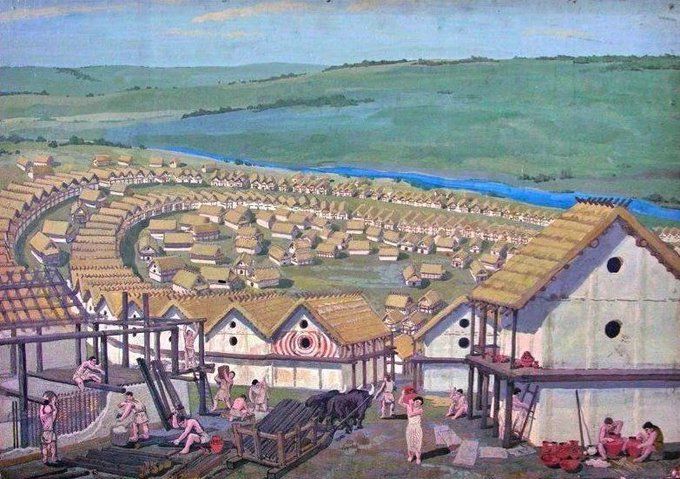According to Wikipedia, Trypillia culture was a Neolithic–Chalcolithic archaeological culture (c. 5500 to 2750 B.C.) of Eastern Europe… During its middle phase (c. 4000 to 3500 B.C.), populations belonging to the Trypillia culture built the largest settlements in Neolithic Europe, some of which contained as many as three thousand structures and were possibly inhabited by 20,000 to 46,000 people… The Trypillia culture is known for its distinctive settlements, architecture, intricately decorated pottery, and anthropomorphic and zoomorphic figurines, which are preserved in archaeological remains. At its peak it was one of the most technologically advanced societies in the world at the time, developing new techniques for ceramic production, housing building, agriculture, and producing woven textiles. Among many other features that still puzzle scholars is the shape of the Trypillian settlements – they were all circular.
Interestingly, in the 4th century B.C., Plato imagined his ideal city of Magnesia in a circular shape too. The foundation plan of Magnesia is given in Laws 745: “The lawgiver must plant his city in the center of the country, choosing a spot which has all the other conveniences a city needs, which are easily learned and specified. Next, he must divide the land into twelve portions, after reserving a sacred area for Hestia, Zeus, and Athena, calling it the Acropolis and building a circular wall round it.”
John Mitchell in his acclaimed “Dimensions of Paradise” explained it this way: On the astronomical scale, Magnesia and the New Jerusalem represent the sublunary world, that is, the earth and its atmosphere under the influence of the moon… The city as a circle represents the heavenly ideal or archetype. That is the model which the rulers of the state are required to study, thus refining their mentalities and imbuing them with the sense of proportion that enables them to govern justly. However, when it comes to planning and running an actual city, Plato tells them to compromise by reducing the ideal to the practical. The heavenly circle is to become the earthly, rationally measured square.”
“Craddle of Civilizations” book has more insights into this mysterious culture and the effect it had on the European civilization.
